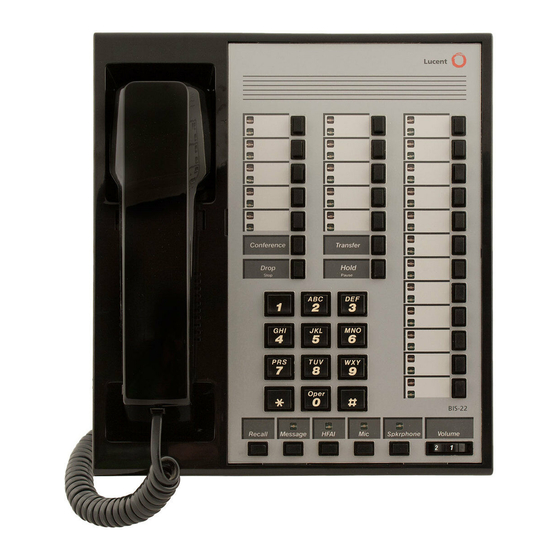
AT&T Merlin BIS 10 Quick Reference
Analog multiline telephones
Hide thumbs
Also See for Merlin BIS 10:
- User manual (75 pages) ,
- System manager's manual (238 pages) ,
- Quick reference (4 pages)
Table of Contents
Advertisement
System Speed Dial
List Most Often Used Codes
Name
1.
2.
3.
4.
5.
6.
7.
8.
9.
10.
11.
12.
13.
14.
15.
16.
17.
1. Do Not Disturb
2.
3.
4.
5.
AT&T CIC# 555-620-121
Code
Posted Messages
6.
7.
8.
9.
10.
Issue 1- October 1992
Account Codes
List Most Often Used Codes
Name
1.
2.
3.
4.
5.
6.
7.
8.
9.
10.
11.
12.
13.
14.
15.
16.
17.
11.
12.
13.
14.
15.
Code
16.
17.
18.
19.
20.
Advertisement
Table of Contents

Summary of Contents for AT&T Merlin BIS 10
- Page 1 System Speed Dial List Most Often Used Codes Name 1. Do Not Disturb AT&T CIC# 555-620-121 Account Codes List Most Often Used Codes Code Posted Messages Issue 1- October 1992 Code Name...
-
Page 2: Line Buttons
TELEPHONE Line Buttons Telephones with SA Buttons Use to make/receive SA Ring ringing calls and receive inside voice- announced calls. Use to make/receive SA Voice outside calls, receive inside ringing and voice-announced calls, and make inside voice- announced calls. (Co-workers hear your voice over the speakerphone.) SA Originate Use only to make inside... -
Page 3: Often Used Features
OFTEN USED FEATURES Forward and Follow Me To program: Label a button. Slide T/P switch to P. Press labeled button. Dial 33. Slide T/P switch to center. To forward calls to an extension: Press an ICOM or SA button. Press programmed button. Dial extension. -
Page 4: Call Handling
CALL HANDLING Line Button Lights Light Meaning Steady red You are automatically connected to this line when you lift the handset. Steady green The line is in use or the feature programmed onto the line button is in use. Steady red You are using this line button or the Line Request and green... -
Page 5: Personal Speed Dial
OFTEN USED FEATURES Auto Dial To program: Label a button. Slide T/P switch to P. Press labeled button. Dial 22 for inside numbers, or 21 for outside numbers. Dial extension or outside number. Include entire dialing sequence, for example, dial-out codes. (See Special Characters Table.) Repeat Steps 3-5 to... -
Page 6: Features & Programming
FEATURES & PROGRAMMING Programming Buttons 1. Label a button. 2. Slide T/P switch to P. 3. Press labeled button. 4. Dial programming code. 5. Repeat Steps 3 and 4 if programming other buttons. 6. Slide T/P switch to center. Programming Codes Account Code Entry Auto Answer All Auto Answer on Intercom... -
Page 7: Account Code Entry
OFTEN USED FEATURES Callback Use Callback to be notified when a busy extension or outside line is free. Callback works only for busy extensions on ICOM button phones; use Line Request for busy outside lines. On SA button phones, Callback works with busy inside extensions;... -
Page 8: Call Waiting
OFTEN USED FEATURES Call Waiting Single beep means inside call waiting; two beeps mean outside call waiting. To turn call waiting on/off: 1. Press Feature and dial 00. 2. Press any ICOM or SA button. 3. Dial 11 to turn on or 11 to turn off. -
Page 9: Do Not Disturb
OFTEN USED FEATURES Do Not Disturb To program: Label a button. Slide T/P switch to P. Press labeled button. Dial Slide T/P switch to center. To use: Toggle the programmed button on and off. Last Number Dial To program: Label a button. Slide T/P switch to P. -
Page 10: Accessing Features
Accessing Features Some features must be programmed onto a line button while others can be accessed from a feature code or a programming code. Other features can be accessed from a feature code only. To access features, use the appropriate method as follows: Dial a feature code: Press Feature button or dial #.



